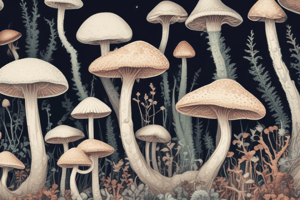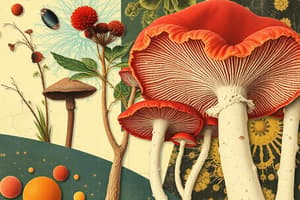Podcast
Questions and Answers
What is the estimated number of potential fungal species?
What is the estimated number of potential fungal species?
- 2,000,000
- 100,000
- 500,000
- 1,500,000 (correct)
Which group does Saccharomyces cerevisiae belong to?
Which group does Saccharomyces cerevisiae belong to?
- Microsporidia
- Moulds
- Ascomycota (correct)
- Basidiomycota
When did the last common ancestor of fungi exist?
When did the last common ancestor of fungi exist?
- 1 million years ago
- 500 million years ago (correct)
- 450,000 years ago
- 1.5 billion years ago
Which group includes typical mushrooms and plant pathogens?
Which group includes typical mushrooms and plant pathogens?
Which of the following is true about fungal dimorphism?
Which of the following is true about fungal dimorphism?
What is the primary consequence of failure to switch dimorphically in fungi?
What is the primary consequence of failure to switch dimorphically in fungi?
What are the causes of fungal diseases?
What are the causes of fungal diseases?
Which group of fungi is the largest and most diverse?
Which group of fungi is the largest and most diverse?
What is the size of Saccharomyces cerevisiae, a unicellular fungus?
What is the size of Saccharomyces cerevisiae, a unicellular fungus?
What are Microsporidia?
What are Microsporidia?
What is a characteristic feature of Microsporidia spores?
What is a characteristic feature of Microsporidia spores?
What do pathogenic fungi switch between?
What do pathogenic fungi switch between?
What is the primary role of fungi in the ecosystem?
What is the primary role of fungi in the ecosystem?
What are the recommended tasks for further study mentioned in the text?
What are the recommended tasks for further study mentioned in the text?
What is the primary role of yeasts in food processing?
What is the primary role of yeasts in food processing?
What is the composition of the rigid cell wall of fungi?
What is the composition of the rigid cell wall of fungi?
How do fungi primarily obtain their nutrients?
How do fungi primarily obtain their nutrients?
What is the function of conidia in fungi?
What is the function of conidia in fungi?
What is the purpose of mycorrhizal fungi in relation to plants?
What is the purpose of mycorrhizal fungi in relation to plants?
What is the primary role of sexual spores in fungi?
What is the primary role of sexual spores in fungi?
What is the main reason for dimorphic switching in fungi?
What is the main reason for dimorphic switching in fungi?
What is the characteristic morphology of most fungi?
What is the characteristic morphology of most fungi?
What is the primary method of asexual reproduction in fungi?
What is the primary method of asexual reproduction in fungi?
What are the three broad categories of ways fungi obtain their food?
What are the three broad categories of ways fungi obtain their food?
What is the role of filamentous fungi in traditional food processes?
What is the role of filamentous fungi in traditional food processes?
What was the first antibiotic derived from a fungus?
What was the first antibiotic derived from a fungus?
What is the size range of Microsporidia spores?
What is the size range of Microsporidia spores?
What is the composition of the inner wall (endospore) of Microsporidia spores?
What is the composition of the inner wall (endospore) of Microsporidia spores?
How do Microsporidia spores infect host cells?
How do Microsporidia spores infect host cells?
Which class of fungal infections is the most serious?
Which class of fungal infections is the most serious?
What is the primary challenge in treating systemic fungal infections?
What is the primary challenge in treating systemic fungal infections?
What makes treatment of systemic fungal infections difficult?
What makes treatment of systemic fungal infections difficult?
Which mechanism of fungal infection is referred to as mycosis?
Which mechanism of fungal infection is referred to as mycosis?
Which of the following fungi is commonly used in traditional food processes?
Which of the following fungi is commonly used in traditional food processes?
Which fungus is known as baker’s yeast?
Which fungus is known as baker’s yeast?
Which group of fungi contains both single-celled and filamentous species?
Which group of fungi contains both single-celled and filamentous species?
What is the primary method by which fungi obtain their nutrients?
What is the primary method by which fungi obtain their nutrients?
What is the primary characteristic of fungi in relation to their nutritional requirements?
What is the primary characteristic of fungi in relation to their nutritional requirements?
What type of relationship does lichen exemplify in terms of obtaining nutrients?
What type of relationship does lichen exemplify in terms of obtaining nutrients?
What is the primary role of the mycobiont in the lichen symbiosis?
What is the primary role of the mycobiont in the lichen symbiosis?
What is the main function of the photobiont in the lichen symbiosis?
What is the main function of the photobiont in the lichen symbiosis?
What is the main visible body of the lichen called?
What is the main visible body of the lichen called?
What is the categorization based on structural characteristics of lichen growth forms?
What is the categorization based on structural characteristics of lichen growth forms?
What is the composition of the uppermost layer of the stratified lichen thallus?
What is the composition of the uppermost layer of the stratified lichen thallus?
What is the primary characteristic of the mycobiont's morphology in lichens?
What is the primary characteristic of the mycobiont's morphology in lichens?
What is the primary role of the thallus morphology in lichens?
What is the primary role of the thallus morphology in lichens?
What is the third partner in the lichen symbiosis referred to as?
What is the third partner in the lichen symbiosis referred to as?
Which layer do crustose lichens attach to directly?
Which layer do crustose lichens attach to directly?
How do fruticose lichens attach to surfaces?
How do fruticose lichens attach to surfaces?
What is the primary role of lichenized fungi?
What is the primary role of lichenized fungi?
What percentage of lichens form 3D structures such as foliose or fruticose?
What percentage of lichens form 3D structures such as foliose or fruticose?
What do photobionts require for photosynthesis?
What do photobionts require for photosynthesis?
What is the primary function of lichens as carbon sinks?
What is the primary function of lichens as carbon sinks?
What is the role of the cyanobacterial partner in lichen symbiosis?
What is the role of the cyanobacterial partner in lichen symbiosis?
What is the significance of lichens as bioindicators?
What is the significance of lichens as bioindicators?
What is the primary role of lichens in relation to air pollution?
What is the primary role of lichens in relation to air pollution?
What is the primary role of lichens in relation to carbon dioxide?
What is the primary role of lichens in relation to carbon dioxide?
What is the primary role of the medulla layer in lichen structure?
What is the primary role of the medulla layer in lichen structure?
Flashcards are hidden until you start studying
Study Notes
Fungal Dimorphism, Disease Classes, and Microsporidia
- Dimorphism in fungi allows them to evade host defenses by residing within phagocytotic cells, shielding them from the immune system
- Failure to switch dimorphically almost always reduces pathogenicity in fungi
- Fungal diseases are caused by inappropriate immune response, toxin production, and host infection (mycosis) with systemic infections being the most serious
- Ascomycota is the largest and most diverse group of fungi, containing single-celled species, filamentous species, and yeasts like Candida albicans
- Saccharomyces cerevisiae is a unicellular fungus, around 6 µm in diameter, studied for basic research and used in biotechnical applications
- Microsporidia are ancient groups of parasitic or saprophytic fungi, closely related to fungi, and infect every vertebrate and invertebrate
- Microsporidia have the smallest genome size of eukaryotes, infect a wide range of hosts, and have three common species that infect humans
- Symptoms of Microsporidia infection include chronic, non-bloody diarrhea and respiratory infections, particularly affecting immunocompromised individuals
- Microsporidia spores are small, non-motile, and highly environmentally resistant, penetrating host cells to begin replication
- Fungi are eukaryotes closer to animals than plants, primarily aerobic, and act as recyclers in the ecosystem
- Pathogenic fungi can switch between multicellular hyphae and single-celled yeasts, with hyphae being septate or coenocytic and forming conidia for spread
- Tasks for further study include reading specific sections of Brock Biology of Microorganisms, exploring Candida albicans as a nosocomial pathogen, and understanding its growth, size, cell shape, and treatment options
Lichen Vegetative Structure and Symbiotic Relationships
- Lichens have a stratified thallus consisting of layers such as the photobiont layer, medulla layer, and lower cortex layer.
- Foliose and fruticose lichens have a lower cortex layer, while crustose and squamulose lichens are directly attached to the substrate at the medulla layer.
- Foliose and fruticose lichens attach to surfaces via rhizines, which secrete extracellular gelatinous materials for attachment.
- Crustose lichens are flatter and closely attached to surfaces, while squamulose lichens have leaf-like areolated thallus structures.
- Fruticose lichens have a shrub or hair-like structure and can resemble plants, with finer, beard-like structures and high surface area for gas diffusion and photosynthesis.
- Lichenized fungi, the mycobiont, are heterotrophic, requiring organic carbon as a carbon source and acquiring carbon from living algae or cyanobacterial cells.
- Lichenized fungi form housing structures that provide adequate lighting and gas exchange for the photobiont, with only about 25% of lichens forming 3D structures such as foliose or fruticose.
- Photobionts are photoautotrophic, requiring light, water, and carbon dioxide for photosynthesis, and release organic carbon, CO2, and minerals leached from the substrate.
- Lichens act as carbon sinks, with 50% of CO2 assimilated during photosynthesis used for respiration and the remaining utilized for thallus cell walls and other compounds.
- Lichens form tripartite symbioses with green algae and cyanobacterial photobionts, with the cyanobacterial partner responsible for nitrogen fixation.
- Lichens serve as bioindicators of air pollution, with fieldwork involving the comparison of lichen biodiversity between car parks and green areas to identify patterns.
- Fieldwork on campus involves photographing all lichens in designated areas, returning to the lecture room for identification, and determining observable patterns in lichen biodiversity.
Studying That Suits You
Use AI to generate personalized quizzes and flashcards to suit your learning preferences.




